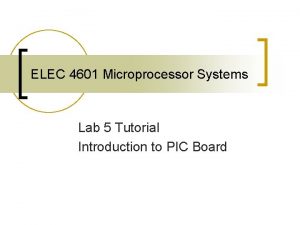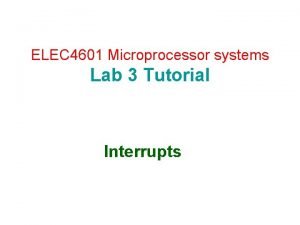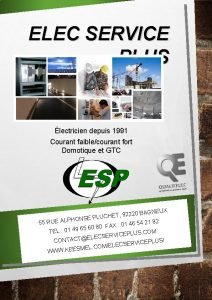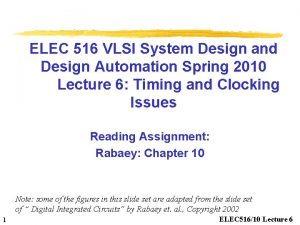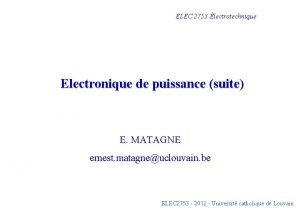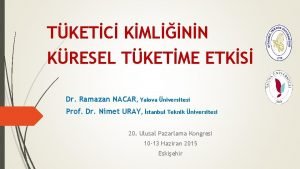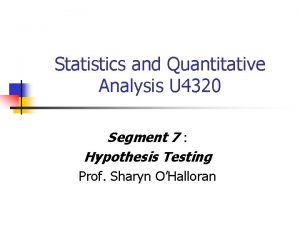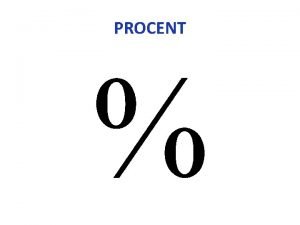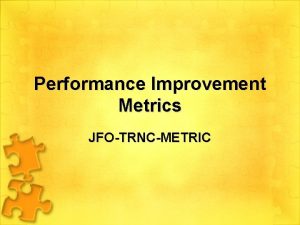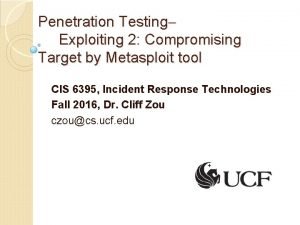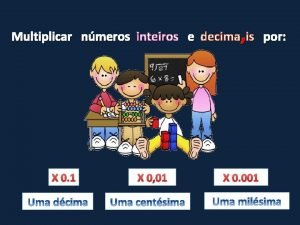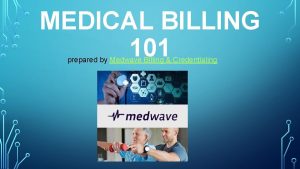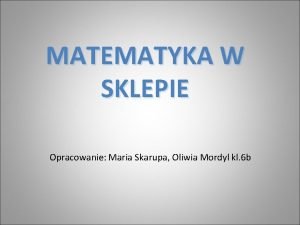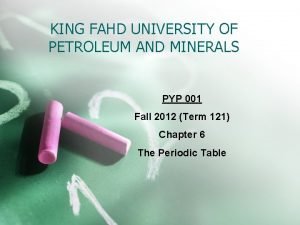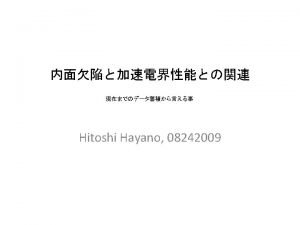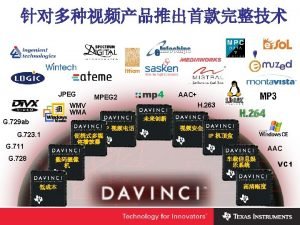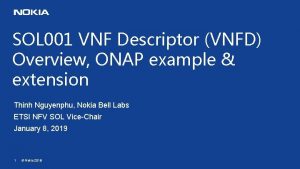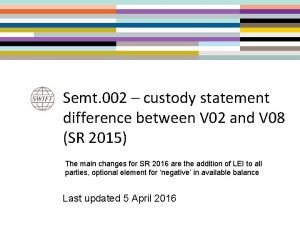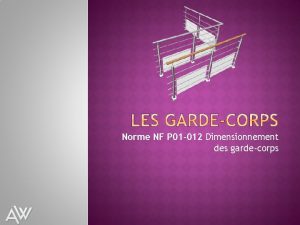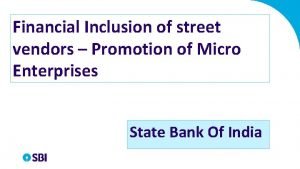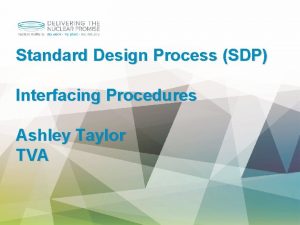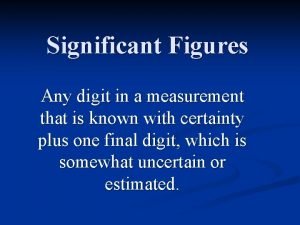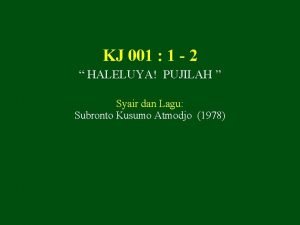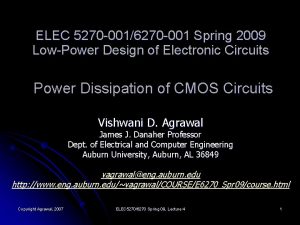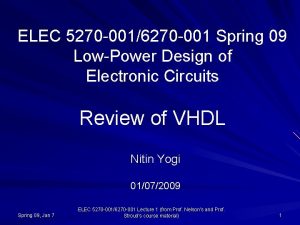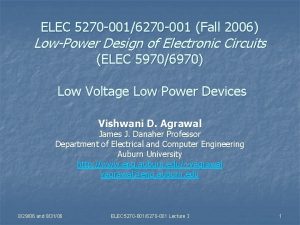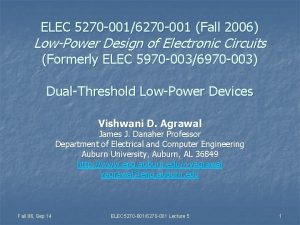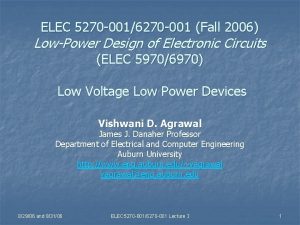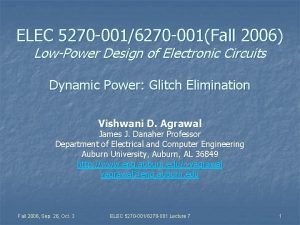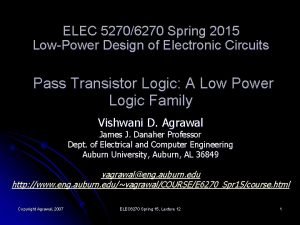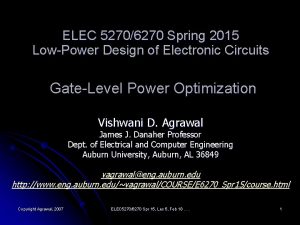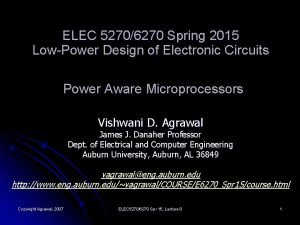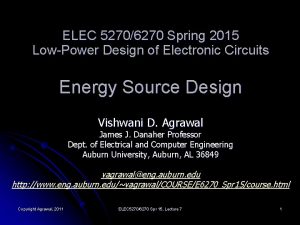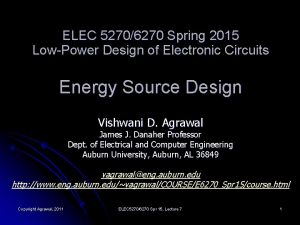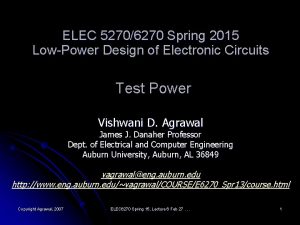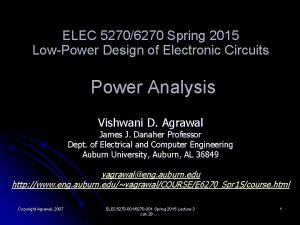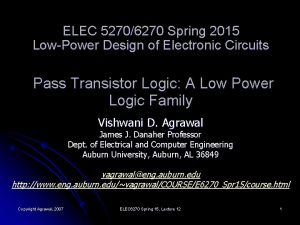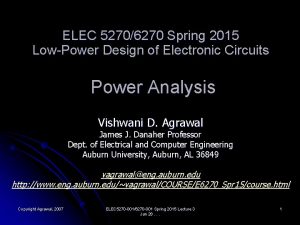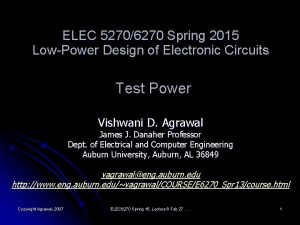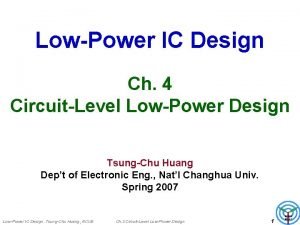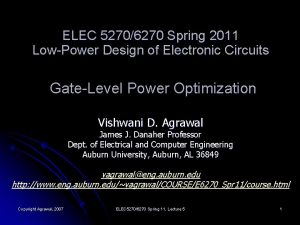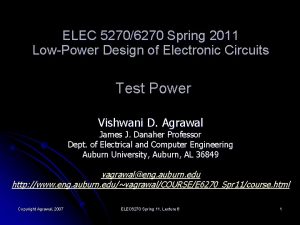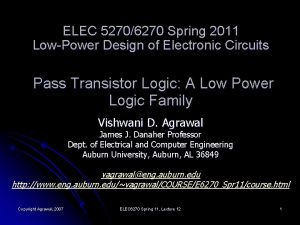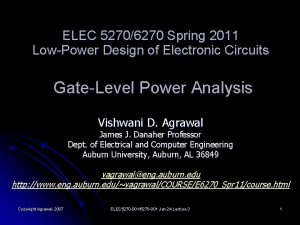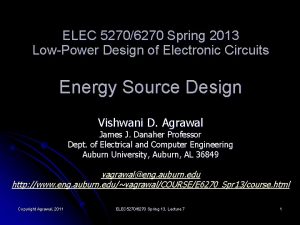ELEC 5270 0016270 001 Spring 2015 LowPower Design



































- Slides: 35

ELEC 5270 -001/6270 -001 Spring 2015 Low-Power Design of Electronic Circuits Introduction to Low Power Design Vishwani D. Agrawal James J. Danaher Professor Dept. of Electrical and Computer Engineering Auburn University, Auburn, AL 36849 vagrawal@eng. auburn. edu http: //www. eng. auburn. edu/~vagrawal/COURSE/E 6270_Spr 15/course. html Copyright Agrawal 2007 ELEC 5270/6270 Spr 2015 Lecture 1 Jan 14. . . 1

Course Objectives Low-power is a current need in VLSI design. l Learn basic ideas, concepts, theory and methods. l Gain experience with techniques and tools. l Copyright Agrawal 2007 ELEC 5270/6270 Spr 2015 Lecture 1 Jan 14. . . 2

Student Evaluation Homework (25%) ~ Four l Class Project (25%) l Class Test (25%): Friday, March 20, 2015, 2: 00 – 2: 50 PM, Broun 235. l Final Exam (25%): Tuesday, May 5, 2015, 4: 00 – 6: 30 PM, Broun 235. l Copyright Agrawal 2007 ELEC 5270/6270 Spr 2015 Lecture 1 Jan 14. . . 3

Power Consumption of VLSI Chips Why is it a concern? Copyright Agrawal 2007 ELEC 5270/6270 Spr 2015 Lecture 1 Jan 14. . . 4

ISSCC, Feb. 2001, Keynote “Ten years from now, microprocessors will run at 10 GHz to 30 GHz and be capable of processing 1 trillion operations per second – about the same number of calculations that the world's fastest supercomputer can perform now. Patrick P. Gelsinger Senior Vice President General Manager Digital Enterprise Group INTEL CORP. Copyright Agrawal 2007 “Unfortunately, if nothing changes these chips will produce as much heat, for their proportional size, as a nuclear reactor. . ” ELEC 5270/6270 Spr 2015 Lecture 1 Jan 14. . . 5

VLSI Chip Power Density Sun’s Surface Power Density (W/cm 2) 10000 Rocket Nozzle 1000 Nuclear Reactor 100 Hot Plate 8086 10 4004 8008 8085 386 286 8080 1 1970 Copyright Agrawal 2007 1980 P 6 Pentium® 486 1990 Year Source: Intel 2000 ELEC 5270/6270 Spr 2015 Lecture 1 Jan 14. . . 2010 6

Recent Data Source: http: //www. eetimes. com/story/OEG 20040123 S 0041 Copyright Agrawal 2007 ELEC 5270/6270 Spr 2015 Lecture 1 Jan 14. . . 7

Year 1999 2002 2005 2008 2011 2014 Feature size (nm) 180 130 100 70 50 35 Logic transistors/cm 2 6. 2 M 18 M 39 M 84 M 180 M 390 M Clock (GHz) 1. 25 2. 1 3. 5 6. 0 10. 0 16. 9 Chip size (mm 2) 340 430 520 620 750 900 Power supply (V) 1. 8 1. 5 1. 2 0. 9 0. 6 0. 5 High-perf. Power (W) 90 130 160 175 183 Untrue predictions. SIA Roadmap for Processors (1999) Source: http: //www. semichips. org Copyright Agrawal 2007 ELEC 5270/6270 Spr 2015 Lecture 1 Jan 14. . . 8

Low-Power Design l Design practices that reduce power consumption by at least one order of magnitude; in practice 50% reduction is often acceptable. l Low-power design methods: l Algorithms and architectures l High-level and software techniques l Gate and circuit-level methods l Test power Copyright Agrawal 2007 ELEC 5270/6270 Spr 2015 Lecture 1 Jan 14. . . 9

VLSI Building Blocks l l l l l Finite-state machine (FSM) Bus Flip-flops and shift registers Memories Datapath Processors Power grid Clock distribution Analog circuits RF components Copyright Agrawal 2007 ELEC 5270/6270 Spr 2015 Lecture 1 Jan 14. . . 10

Specific Topics in Low-Power l l Power dissipation in CMOS circuits Device technology l l l Circuit and gate level methods l l l l Logic synthesis Dynamic power reduction techniques Leakage power reduction System level methods l l Low-power CMOS technologies Energy recovery methods Microprocessors Arithmetic circuits Low power memory technology Test Power grid and clock network Power estimation Copyright Agrawal 2007 ELEC 5270/6270 Spr 2015 Lecture 1 Jan 14. . . 11

Some Examples Copyright Agrawal 2007 ELEC 5270/6270 Spr 2015 Lecture 1 Jan 14. . . 12

State Encoding for a Counter l Two-bit binary counter: l State sequence, 00 → 01 → 10 → 11 → 00 l Six bit transitions in four clock cycles l 6/4 = 1. 5 transitions per clock l Two-bit Gray-code counter l State sequence, 00 → 01 → 10 → 00 l Four bit transitions in four clock cycles l 4/4 = 1. 0 transition per clock l Gray-code counter is more power efficient. G. K. Yeap, Practical Low Power Digital VLSI Design, Boston: Kluwer Academic Publishers (now Springer), 1998. Copyright Agrawal 2007 ELEC 5270/6270 Spr 2015 Lecture 1 Jan 14. . . 13

Binary Counter: Original Encoding Present state a Next state b a 0 b 0 A 0 B 1 0 1 1 1 0 0 1 0 A = a’b + ab’ = a xor b B = a’b’ + ab’ = b’ Copyright Agrawal 2007 A B CK CLR ELEC 5270/6270 Spr 2015 Lecture 1 Jan 14. . . 14

Binary Counter: Gray Encoding Present state Next state a 0 b 0 A 0 B 1 0 1 1 0 0 A B b a A = a’b + ab = b B = a’b’ + a’b = a’ Copyright Agrawal 2007 CK CLR ELEC 5270/6270 Spr 2015 Lecture 1 Jan 14. . . 15

Three-Bit Counters State Binary No. of toggles Gray-code State No. of toggles 000 - 001 1 010 2 011 1 010 1 100 3 110 1 101 1 110 2 101 1 111 1 100 1 000 3 000 1 Av. Transitions/clock = 1. 75 Copyright Agrawal 2007 Av. Transitions/clock = 1 ELEC 5270/6270 Spr 2015 Lecture 1 Jan 14. . . 16

N-Bit Counter: Toggles in Counting Cycle l l l Binary counter: T(binary) = 2(2 N – 1) Gray-code counter: T(gray) = 2 N T(gray)/T(binary) = 2 N-1/(2 N – 1) → 0. 5 Bits T(binary) T(gray)/T(binary) 1 2 2 1. 0 2 6 4 0. 6667 3 14 8 0. 5714 4 30 16 0. 5333 5 62 32 0. 5161 6 126 64 0. 5079 ∞ - - 0. 5000 Copyright Agrawal 2007 ELEC 5270/6270 Spr 2015 Lecture 1 Jan 14. . . 17

FSM State Encoding Transition probability based on PI statistics 0. 6 11 0. 3 0. 4 00 0. 6 0. 1 0. 3 0. 1 01 01 0. 4 0. 9 00 0. 6 0. 1 11 0. 9 Expected number of state-bit transitions: 2(0. 3+0. 4) + 1(0. 1+0. 1) = 1. 6 1(0. 3+0. 4+0. 1) + 2(0. 1) = 1. 0 State encoding can be selected using a power-based cost function. Copyright Agrawal 2007 ELEC 5270/6270 Spr 2015 Lecture 1 Jan 14. . . 18

FSM: Clock-Gating l Moore machine: Outputs depend only on the state variables. l If a state has a self-loop in the state transition graph (STG), then clock can be stopped whenever a self-loop is to be executed. Xi/Zk Si Sk Sj Copyright Agrawal 2007 Xj/Zk Xk/Zk Clock can be stopped when (Xk, Sk) combination occurs. ELEC 5270/6270 Spr 2015 Lecture 1 Jan 14. . . 19

Clock-Gating in Moore FSM Flip-flops PI Clock activation logic CK Copyright Agrawal 2007 Latch Combinational logic PO L. Benini and G. De Micheli, Dynamic Power Management, Boston: Springer, 1998. ELEC 5270/6270 Spr 2015 Lecture 1 Jan 14. . . 20

Bus Encoding for Reduced Power l Example: Four bit bus l 0000 → 1110 has three transitions. l If bits of second pattern are inverted, then 0000 → 0001 will have only one transition. Bit-inversion encoding for N-bit bus: Number of bit transitions after inversion encoding l Copyright Agrawal 2007 N N/2 0 0 N/2 Number of bit transitions ELEC 5270/6270 Spr 2015 Lecture 1 Jan 14. . . N 21

Sent data Received data Bus-Inversion Encoding Logic Polarity decision logic Copyright Agrawal 2007 Bus register Polarity bit M. Stan and W. Burleson, “Bus-Invert Coding for Low Power I/O, ” IEEE Trans. VLSI Systems, vol. 3, no. 1, pp. 49 -58, March 1995. ELEC 5270/6270 Spr 2015 Lecture 1 Jan 14. . . 22

Clock-Gating in Low-Power Flip-Flop D D Q CK Copyright Agrawal 2007 ELEC 5270/6270 Spr 2015 Lecture 1 Jan 14. . . 23

Example: Benchmark S 5378 l l TSMC 025 CMOS technology 50 ns clock 1, 000 random vectors Reference: J. D. Alexander, Simulation Based Power Estimation for Digital CMOS Technologies, Master’s Thesis, Auburn University, December 2008, Section 3. 8. Clock Number of comb. of flipgates flops Power consumption in μW Comb. gates Flip-flops Total Ungated 2, 958 179 330 752 1, 082 Gated 3, 316 179 276 32 308 Copyright Agrawal 2007 ELEC 5270/6270 Spr 2015 Lecture 1 Jan 14. . . 24

Example: Shift Register D D Q D Q Output D Q D Q CK Copyright Agrawal 2007 ELEC 5270/6270 Spr 2015 Lecture 1 Jan 14. . . 25

Reduced-Power Shift Register D Q D Q multiplexer D D Q D Q D Output Q CK(f/2) Flip-flops are operated at full voltage and half the clock frequency. Copyright Agrawal 2007 ELEC 5270/6270 Spr 2015 Lecture 1 Jan 14. . . 26

Power Consumption of Shift Register 16 -bit shift register, 2μ CMOS Freq (MHz) Power (μW) 1 33. 0 1535 2 16. 5 887 4 8. 25 738 C. Piguet, “Circuit and Logic Level Design, ” pages 103 -133 in W. Nebel and J. Mermet (ed. ), Low Power Design in Deep Submicron Electronics, Springer, 1997. Copyright Agrawal 2007 1. 0 Normalized power Deg. of parallelism P = C’VDD 2 f/n 0. 5 0. 25 0. 0 1 2 4 Degree of parallelism, n ELEC 5270/6270 Spr 2015 Lecture 1 Jan 14. . . 27

Books on Low-Power Design (1) l l l l L. Benini and G. De Micheli, Dynamic Power Management Design Techniques and CAD Tools, Boston: Springer, 1998. T. D. Burd and R. A. Brodersen, Energy Efficient Microprocessor Design, Boston: Springer, 2002. A. Chandrakasan and R. Brodersen, Low-Power Digital CMOS Design, Boston: Springer, 1995. A. Chandrakasan and R. Brodersen, Low-Power CMOS Design, New York: IEEE Press, 1998. J. -M. Chang and M. Pedram, Power Optimization and Synthesis at Behavioral and System Levels using Formal Methods, Boston: Springer, 1999. D. Chinnery and K. Keutzer, Closing the Power Gap Between ASIC & Custom: Tools and Techniques for Low Power Design, Springer, 2007, ISBN 0387257632, 9780387257631. M. S. Elrabaa, I. S. Abu-Khater and M. I. Elmasry, Advanced Low. Power Digital Circuit Techniques, Boston: Springer, 1997. Copyright Agrawal 2007 ELEC 5270/6270 Spr 2015 Lecture 1 Jan 14. . . 28

Books on Low-Power Design (2) l l l l P. Girard, N. Nicolici and X. Wen, Power-Aware Testing and Test Strategies for Low Power Devices, Springer, 2010. R. Graybill and R. Melhem, Power Aware Computing, New York: Plenum Publishers, 2002. S. Iman and M. Pedram, Logic Synthesis for Low Power VLSI Designs, Boston: Springer, 1998. M. Keating, D. Flynn, R. Aitken, A. Gibbons and K. Shi, Low Power Methodology Manual For System-on-Chip Design, 1 st ed. 2007. Corr. 2 nd printing, 2007, XVI, 304 p. , Hardcover, ISBN: 978 -0 -38771818 -7. J. B. Kuo and J. -H. Lou, Low-Voltage CMOS VLSI Circuits, New York: Wiley-Interscience, 1999. J. Monteiro and S. Devadas, Computer-Aided Design Techniques for Low Power Sequential Logic Circuits, Boston: Springer, 1997. S. G. Narendra and A. Chandrakasan, Leakage in Nanometer CMOS Technologies, Boston: Springer, 2005. Copyright Agrawal 2007 ELEC 5270/6270 Spr 2015 Lecture 1 Jan 14. . . 29

Books on Low-Power Design (3) l l l l W. Nebel and J. Mermet, Low Power Design in Deep Submicron Electronics, Boston: Springer, 1997. N. Nicolici and B. M. Al-Hashimi, Power-Constrained Testing of VLSI Circuits, Boston: Springer, 2003. V. G. Oklobdzija, V. M. Stojanovic, D. M. Markovic and N. Nedovic, Digital System Clocking: High Performance and Low-Power Aspects, Wiley-IEEE, 2005. M. Pedram and J. M. Rabaey, Power Aware Design Methodologies, Boston: Springer, 2002. C. Piguet, Low-Power Electronics Design, Boca Raton: Florida: CRC Press, 2005. J. M. Rabaey and M. Pedram, Low Power Design Methodologies, Boston: Springer, 1996. S. Roudy, P. K. Wright and J. M. Rabaey, Energy Scavenging for Wireless Sensor Networks, Boston: Springer, 2003. Copyright Agrawal 2007 ELEC 5270/6270 Spr 2015 Lecture 1 Jan 14. . . 30

Books on Low-Power Design (4) l l l K. Roy and S. C. Prasad, Low-Power CMOS VLSI Circuit Design, New York: Wiley-Interscience, 2000. E. Sánchez-Sinencio and A. G. Andreaou, Low-Voltage/Low-Power Integrated Circuits and Systems – Low-Voltage Mixed-Signal Circuits, New York: IEEE Press, 1999. W. A. Serdijn, Low-Voltage Low-Power Analog Integrated Circuits, Boston: Springer, 1995. S. Sheng and R. W. Brodersen, Low-Power Wireless Communications: A Wideband CDMA System Design, Boston: Springer, 1998. G. Verghese and J. M. Rabaey, Low-Energy FPGAs, Boston: Springer, 2001. G. K. Yeap, Practical Low Power Digital VLSI Design, Boston: Springer, 1998. K. -S. Yeo and K. Roy, Low-Voltage Low-Power Subsystems, Mc. Graw Hill, 2004. Copyright Agrawal 2007 ELEC 5270/6270 Spr 2015 Lecture 1 Jan 14. . . 31

Books Useful in Low-Power Design l l l l A. Chandrakasan, W. J. Bowhill and F. Fox, Design of High. Performance Microprocessor Circuits, New York: IEEE Press, 2001. R. C. Jaeger and T. N. Blalock, Microelectronic Circuit Design, Third Edition, Mc. Graw-Hill, 2006. S. M. Kang and Y. Leblebici, CMOS Digital Integrated Circuits, New York: Mc. Graw-Hill, 1996. E. Larsson, Introduction to Advanced System-on-Chip Test Design and Optimization, Springer, 2005. J. M. Rabaey, A. Chandrakasan and B. Nikolić, Digital Integrated Circuits, Second Edition, Upper Saddle River, New Jersey: Prentice. Hall, 2003. J. Segura and C. F. Hawkins, CMOS Electronics, How It Works, How It Fails, New York: IEEE Press, 2004. N. H. E. Weste and D. Harris, CMOS VLSI Design, Third Edition, Reading, Massachusetts: Addison-Wesley, 2005. Copyright Agrawal 2007 ELEC 5270/6270 Spr 2015 Lecture 1 Jan 14. . . 32

Problem: Bus Encoding A 1 -hot encoding is to be used for reducing the capacitive power consumption of an n-bit data bus. All n bits are assumed to be independent and random. Derive a formula for the ratio of power consumptions on the encoded and the un-coded buses. Show that n ≥ 4 is essential for the 1 -hot encoding to be beneficial. Reference: A. P. Chandrakasan and R. W. Brodersen, Low Power Digital CMOS Design, Boston: Kluwer Academic Publishers, 1995, pp. 224 -225. [Hint: You should be able to solve this problem without the help of the reference. ] Copyright Agrawal 2007 ELEC 5270/6270 Spr 2015 Lecture 1 Jan 14. . . 33

Solution: Bus Encoding Un-coded bus: Two consecutive bits on a wire can be 00, 01, 10 and 11, each occurring with a probability 0. 25. Considering only the 0→ 1 transition, which draws energy from the supply, the probability of a data pattern consuming CV 2 energy on a wire is ¼. Therefore, the average per pattern energy for all n wires of the bus is CV 2 n/4. Encoded bus: Encoded bus contains 2 n wires. The 1 -hot encoding ensures that whenever there is a change in the data pattern, exactly one wire will have a 01 transition, charging its capacitance and consuming CV 2 energy. There can be 2 n possible data patterns and exactly one of these will match the previous pattern and consume no energy. Thus, the per pattern energy consumption of the bus is 0 with probability 2–n, and CV 2 with probability 1 – 2–n. The average per pattern energy for the 1 -hot encoded bus is CV 2(1 – 2–n). Copyright Agrawal 2007 ELEC 5270/6270 Spr 2015 Lecture 1 Jan 14. . . 34

Solution: Bus Encoding (Cont. ) Power ratio = Encoded bus power / un-coded bus power = 4(1 – 2–n)/n → 4/n for large n For the encoding to be beneficial, the above power ratio should be less than 1. That is, 4(1 – 2–n)/n ≤ 1, or 1 – 2–n ≤ n/4, or n/4 ≥ 1 (approximately) → n ≥ 4. The following table shows 1 -hot encoded bus power ratio as a function of bus width: n 4(1 – 2–n)/n 1 2. 0000 8 0. 4981 2 1. 5000 16 0. 2500 = 1/4 3 1. 1670 32 1/8 4 0. 9375 64 1/16 Copyright Agrawal 2007 ELEC 5270/6270 Spr 2015 Lecture 1 Jan 14. . . 35
 Elec 4601
Elec 4601 Elec4601
Elec4601 Elec service plus
Elec service plus Picture recognition
Picture recognition Dec alpha 21264
Dec alpha 21264 Elec
Elec Elec
Elec Elec 202
Elec 202 Spring break 2015
Spring break 2015 Spring, summer, fall, winter... and spring cast
Spring, summer, fall, winter... and spring cast Is may in spring or summer
Is may in spring or summer Mehmet nacar 001
Mehmet nacar 001 How to find t critical value
How to find t critical value Förändringsfaktor
Förändringsfaktor Acad 02-001
Acad 02-001 Ms 08-067
Ms 08-067 Nom 001 stps 2008 edificios locales e instalaciones
Nom 001 stps 2008 edificios locales e instalaciones Multiplicação por 0 1 0 01 e 0 001
Multiplicação por 0 1 0 01 e 0 001 H4279 001 01 - hmo
H4279 001 01 - hmo 650 dag ile to kg
650 dag ile to kg Pyp-001
Pyp-001 Aes 001
Aes 001 011 101 110
011 101 110 644 x 12
644 x 12 Vnfd
Vnfd Semt.002
Semt.002 Write 702 001 in expanded form
Write 702 001 in expanded form Nf p01 012
Nf p01 012 Easa cm-swceh-001
Easa cm-swceh-001 In mudra loan rs.50 001 to rs.500 000 are categorised as
In mudra loan rs.50 001 to rs.500 000 are categorised as Auec2-004
Auec2-004 Ip-eng-001
Ip-eng-001 How many significant figures are in 3,000,001
How many significant figures are in 3,000,001 Servicenow demo 001
Servicenow demo 001 Nkb 197
Nkb 197 Pyp 001 kfupm
Pyp 001 kfupm
